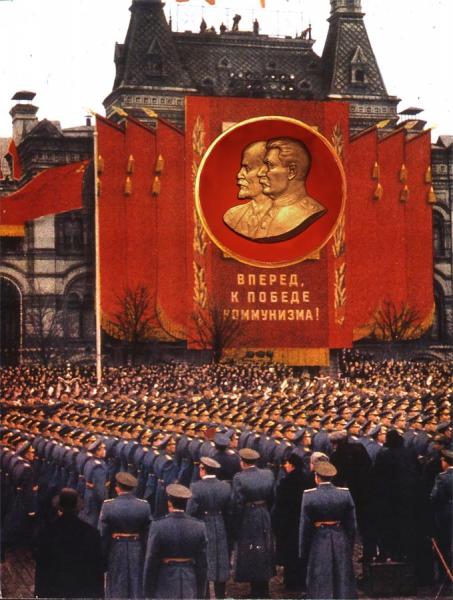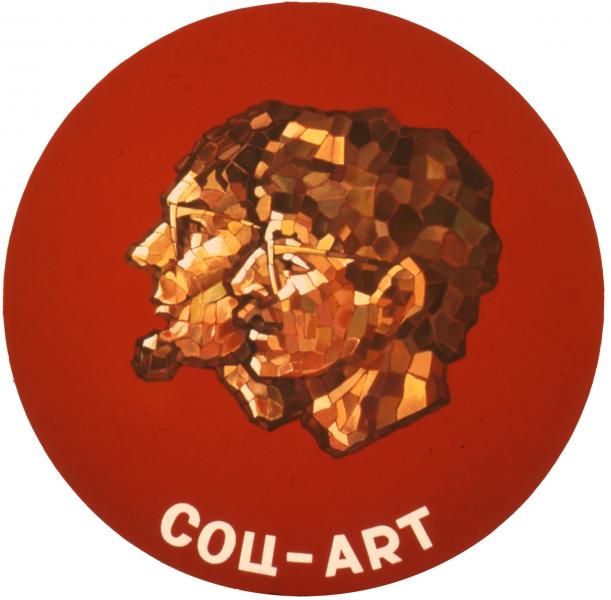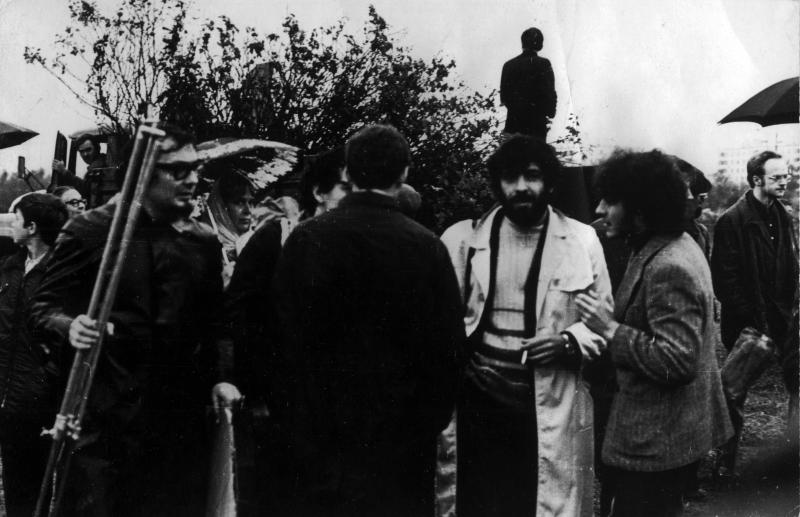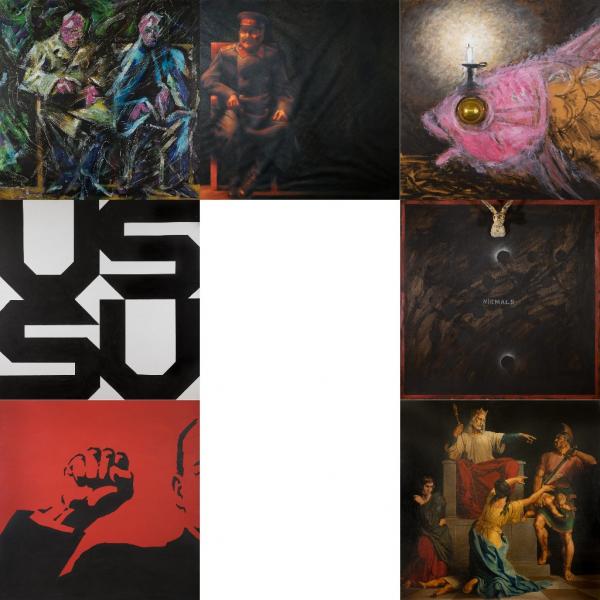
Vitaly Komar: The Avant-Garde, Sots-Art and the Bulldozer Exhibition of 1974

I greatly admire the art of Vitaly Komar as well as his collaborations with Alex Melamid. When Vitaly and Anna Halberstadt were visiting with Susan Bee and me last week, our conversation turned toward Russian Futurism, OBERU, and the more contemporary Moscow Conceptualism. It turns out Vitaly went to art school with Dmitri Prigov, whose Soviet Texts was recently published by Ugly Duckling Press. About Prigov's new book, I wrote: "This Prigov cocktail is a knockout: one part Brecht, one part Jarry, one part OBERIU, a twist of bitters; shaken, not stirred. Prigov is the unparalleled debunker of the Soviet unconscious. His conceptual audacity, verbal pyrotechnics, and hilarious political satire have made him one of the premiere innovative poets and parabolists of the postwar generation. Simon Schuchat brings to life, in English, this essential Russian artist."
Vitaly sent me this essay and I am glad to present it here.
1. The Avant-Garde and the Roots of Unofficial Art 
The Russian avant-garde’s revolutionary struggle with the traditions of the old culture led to the division of art into ‘official’ and ‘unofficial.’ Prior to World War I, the first avant-garde opposed the academic salon art that was fashionable at the time. After World War II and Stalin’s death, the second avant-garde opposed official Socialist Realism. However, by that time Soviet Russia’s unofficial artists had shed the naïve nihilism of the early 20th century avant-garde. They were aware of the ancient Roman aphorism: “The new is simply what has been well forgotten.” They believed in the value of pluralism, in the gradual evolution of fashion, and certain traits of their art were reminiscent of late modernism.
[image above: Soviet visual propaganda on the Red Square. Lenin and Stalin with official political slogen (1950s)]
An eclectic crowd was unified under the banner of opposition to the Soviet regime: it ranged from liberals and Trotskyites to religious nationalists and criminals. For unofficial artists, this conceptual eclecticism was an alternative to the tragic extremism of the revolutionary years, when the Russian avant-garde became the ‘official’ art of the regime. Rather, it played the role of the “King of the Carnival,” who was then sacrificed at the dawn of Stalinist culture. It is curious that Lenin, unlike Mussolini, didn’t like the Futurists; however he used their anarchic energy to destroy a number of bourgeois traditions that hindered his pursuit of power. In the first years of the revolution, avant-gardists established a bureaucratic state system of support for art, and they enjoyed the privileges of the Soviet elite. The majority of old-fashioned realist artists were the unofficial non-conformists starving in the underground during the short-lived revolutionary carnival. True, they took their revenge. After staging a ‘palace coup’ and seizing power, put avant-garde artists on a diet of bread and water. We often forget today that the post-Revolutionary avant-garde and Soviet official realism were two sides of one coin, of one socialist utopia.
The “Soviet experiment” provides a lesson in paradox: during historical periods of avant-garde elitism, the role of the true avant-garde may actually be played by any vibrant irritant of elite taste, including tomorrow’s “counter-avant-garde” of the art market .
In order to grasp the historical roots of Russian culture’s division into official and unofficial, it should be recalled that the first Russian professional unions were established just after the February revolution in 1917. Artists of all styles and schools united into one Union of Cultural Workers. After the Bolsheviks disbanded the Constituent Assembly and forbade opposition parties and press, all the unions went on strike. A split took place: the avant-garde artists became “strikebreakers” and were given government positions and commissions. The recalcitrant leaders of several other unions, teachers and bakers, for example, were executed. As Lenin said, “world war has transformed into civil war.”
 The division of Soviet Russian art into official and unofficial was a latent continuation of the civil war and an echo of the great, forgotten strike. At the beginning of the 1930s, “Socialist Realism” won out. All artistic organizations were banned, and the avant-garde was exiled from Soviet museums into the underground. was forbidden to exhibit, its works were not allowed to be reproduced in art magazines. Only the “conceptual branch” of the Russian avant-garde remained-- but outside museum walls and exhibition halls. The red banners and slogans of Agitprop openly survived on the streets throughout the Stalinist period. Thus, official art was further divided into the art of the elite and the mass art of the people. For years no one realized that in the 20th century USSR, within the framework of totalitarian Art-Deco, there existed not only official “Socialist Realism,” but “official conceptualism” as well. The latter wasn’t acknowledged by art historians for decades, just as the street art of western advertising was not recognized until the arrival of Pop art, which unified mass and elite art, placing popular images in a museum context.
The division of Soviet Russian art into official and unofficial was a latent continuation of the civil war and an echo of the great, forgotten strike. At the beginning of the 1930s, “Socialist Realism” won out. All artistic organizations were banned, and the avant-garde was exiled from Soviet museums into the underground. was forbidden to exhibit, its works were not allowed to be reproduced in art magazines. Only the “conceptual branch” of the Russian avant-garde remained-- but outside museum walls and exhibition halls. The red banners and slogans of Agitprop openly survived on the streets throughout the Stalinist period. Thus, official art was further divided into the art of the elite and the mass art of the people. For years no one realized that in the 20th century USSR, within the framework of totalitarian Art-Deco, there existed not only official “Socialist Realism,” but “official conceptualism” as well. The latter wasn’t acknowledged by art historians for decades, just as the street art of western advertising was not recognized until the arrival of Pop art, which unified mass and elite art, placing popular images in a museum context.
[image above: Sots-Art -- Komar & Melamid, "Double Self-Portrait as Lenin and Stalin" (1972)]
Like all tyrants, Stalin was short-sighted. The dictator hadn’t understood that in seizing half of Europe, he had actually led a Trojan horse in behind the iron curtain. After his death, “unofficial artists” gradually began to peek out from underground. During Khrushchev’s thaw, Yugoslavian, Polish, Hungarian, Czechoslovakian, Bulgarian, Rumanian, Albanian and German art books and magazines appeared in Moscow. They had no less an influence on my friends and me than the ideas of the Prague Spring had on Mikhail Gorbachev and other perestroika activists.
During my youth, artists of the second avant-garde, to which I belonged, were called “non-conformist” and even “dissident.” Our art was termed underground and unofficial. Despite this, when I studied at the Stroganov Art Institute, the art works of a few unofficial artists began to appear in official exhibitions. This process came to an abrupt halt in 1962 at a huge exhibition in Moscow’s Manège, when there was a confrontation between Khrushchev and the sculptor Ernst Neizvestny. After that, public poetry readings at the monument to Mayakovsky were forbidden as well.
2. Sots-art and the motivation of the unofficial artist.
After Leonid Brezhnev came to power, Russian art entered a new stage. At the beginning of the 1970s “Sots-art” appeared—a conceptual movement that united unofficial and official art for the first time. [“Sots-art,” A Dictionary of Twentieth-Century Art, by Ian Chilvers, Oxford University Press, 1998.) This method was apparent not only in Russian art, but later Chinese art as well. Sots-art combined the conceptual branch of the Russian avant-garde—the banners and slogans of Agitprop-- with a dangerous nonconformist gesture. It filled Socialist Realist form with the content of opposition. This unusual creative approach was an expression of the fundamental duality and conceptual eclecticism of our consciousness.
 Sots-art was closer to conceptualism than was Pop art. If Pop art was resulted from the overproduction of goods and advertising, Sots-art emerged from the overproduction of Soviet ideology and its visual propaganda. Having lived in New York for many years now, I see western advertising as “consumerist propaganda” and Soviet propaganda as “ideological advertising.”
Sots-art was closer to conceptualism than was Pop art. If Pop art was resulted from the overproduction of goods and advertising, Sots-art emerged from the overproduction of Soviet ideology and its visual propaganda. Having lived in New York for many years now, I see western advertising as “consumerist propaganda” and Soviet propaganda as “ideological advertising.”
[image above: Vitaly Komar, Diptych ""The Sun and the Moon. 1917-2017"]
As one of the founders of Sots-art, I’d like to share my view of some of the psychological motives driving independent artistic creation when Soviet censorship reigned and there was a total absence of anything resembling a capitalist market. In this text the pronouns “I” and “we” are deliberately interchangeable—not only because at the time Alexander Melamid and I were co-artists, i.e. worked together as a single artist, but also because any artist’s participation in a movement or style is always a form of unconscious collective authorship.
At the time, our criteria for gauging the success of our art had nothing to do with making a career no matter what the price. Most important to us was fulfilling our fantasies of freedom and independence. In trying to do this, we created our own curtain inside the Iron Curtain. It was an ephemeral curtain delineating a bohemian ghetto: a fragile model of the provincial eccentric’s behavior in a totalitarian society. It was an attempt to preserve a mythological, almost perverse loyalty to our principles and image of self-worth. We were all attached to the old-fashioned, romantic notion of the “unacknowledged genius.”
Inevitably, this drew us in to a dangerous game with the “censor as a viewer” and with “the viewer as censor. Visual metaphors became protective masks as well as allegories. The ‘carnival’ we created both mixed and juxtaposed form and content, parody and travesty, context and subtext. Our work was the development of our own artistic biography, and of our common historical context. At the same time, it was assumed that “historical value” would sooner or later become esthetic value. The artist’s life was seen as a work of art, as the “novelization” of the artist’s life. In 1973 Alex Melamid and I created two artists: their paintings, biographies, letters, documents concerning them, and so forth. One of them, Appeles Ziablov, was the first abstract painter. Ziablov was a serf who lived in the 18th century; in protest against the style of the official Academy of Arts that he was forced to conform to, he hung himself. The life of the second artist, Nikolai Buchumov, was no less dramatic. An argument with a left-wing avant-garde turned into a fistfight and the artist punched him, leaving him blind in his left eye. Buchumov then left Moscow and lived the life of a hermit; he painted landscapes, and as a true realist he faithfully depicted his nose on the left side of his paintings.
We saw our art as creating a conceptual history; our materials were not only photography, painting, text, installation and performance-- but time itself. The contextual process of art’s creation was the more important in our evaluation of our work than the finished artwork itself. It seemed to me that the era of class struggle had mutated into an era of the struggle between contexts.
The Russian avant-garde called for Alexander Pushkin to be thrown off the ship of modernity. But I think that the following lines from Pushkin’s own poetry actually shed light on the avant-garde’s most secret desire:
All that threatens us with peril,
An inexplicable pleasure does hold…
For the hearts of mortals.
As I already said, our art led to a dangerous opposition to totalitarian censorship. In effect, our art was a manifestation of the self-destructive impulse of the subconscious. The Russian characters in Sacher-Masoch’s novels made it clear that there is no contradiction between hedonism and the desire for self-destruction. In this light, today we can see Van Gogh’s suffering and suicide as a travesty of the “crucified artist.” Both Christ and Van Gogh were recognized only by a narrow circle of followers during their lifetime. It is no coincidence that Van Gogh was a preacher in his youth. When he cut off his ear, he was subconsciously repeating the action of Saint Peter, who, according to the Gospel of John, cut off the ear of the high priest’s guard in the garden of Gethsemane. The great Vincent thus saw himself as the guard and the apostle simultaneously. He was the self-destructive enemy and his own follower at the same time. And in this regard, I believe that one of the earliest analogies to unofficial art is the catacomb art culture of ancient Rome. Paradoxically, the mysterious “self-destructive instinct “ is many-faceted: it can manifest itself as altruism, masochism, self-sacrifice in the name of ideas or children, as well as in alcoholism or drug addiction.
 3. The Bulldozer exhibition and the Apogee of Unofficial Art.
3. The Bulldozer exhibition and the Apogee of Unofficial Art.
Apartment exhibitions were unique to the second Russian avant-garde. In the spring of 1974, at one of those “apartment exhibitions,” during a Sots-art performance, everyone was arrested, including the veteran unofficial artist Oskar Rabin, and myself. We were interrogated all night. Unable to find anything criminal in our actions, the police released us the next morning. Much as they wanted to, the authorities could find nothing objectionable in the performance. The performance was noisy—Soviet marches were played, and my colleague Alex Melamid and I, playing Stalin and Lenin, shouted commands into a microphone to artists on a stage. Under our direction they created a huge Socialist Realist canvas depicting the heroic labor of Soviet workers. When there was an unexpected knock on the door and the police appeared, the initially audience laughed—people thought that this was part of the performance.
[image above: Bulldozer Show September, 15 1974]
A few days after the arrests, Oskar called me and proposed repeating the performance at the apartment of his friend, the poet Alexander Glezer. This time the performance went through without any brouhaha and we began to discuss new ways of showing our art. We couldn’t use the exhibition halls; unofficial art was not allowed there. But the great outdoors seemed possible. We believed that the authorities were changing their attitude toward artists. I even wrote a proposal for the creation of a second, alternative artists union. Though this project eventually came to be, there was dramatic public outcry just months after the performance. The “Bulldozer Exhibition” became was the apogee of unofficial art’s history. On September 15, 1974, in the Moscow park Belyaevo, the authorities destroyed art by many unofficial artists, among them Oskar Rabin, Lidia Masterkova, Evgeny Rukhin, Vladimir Nemukhin, and Alexander Melamid and me. Today, few people can imagine the sensational flood of international press this confrontation elicited. I’ll never forget the words of the legendary BBC commentator Maksim Goldberg: “Many bureaucrats in the west would love to send bulldozers out to destroy contemporary art, but the laws of the land don’t allow them to.”
When I saw the bulldozers heading our way, any illusions I may have entertained regarding Soviet law disappeared instantly. I watched in a trance as people in plain clothes destroyed our art and professionally beat and arrested whoever resisted them. I froze. But when they knocked me down into the autumn mud and grabbed my painting Double Self-Portrait: Komar and Melamid as Lenin and Stalin, my fear vanished. A number of our Sots-art pieces had already been mangled, but the “Self-portrait” was particularly important to me. When one of them stepped on the picture, intending to smash it, I suddenly imagined that it was a self-portrait of us not as Lenin or Stalin, but as Tolstoy or Gandhi. I raised my head, and quietly, in a trusting voice, said: “What are you doing? This is a masterpiece!” Our eyes met and a different sort of contact arose inexplicably. Perhaps on hearing the word “masterpiece” he remembered something long forgotten. I don’t know, but he didn’t smash the work, he simply tossed it into the back of a truck. A moment later, still lying in the mud, my eyes followed the garbage-filled truck as it drove off into history. I smiled. Was this my “finest hour.”? Maybe every artist secretly dreams of his work being destroyed by the viewer?
As you can well imagine now, I have no intention of excavating the 1970s layers of Moscow landfill to find it.
Like all avant-garde artists, we dreamed of breaking down the barrier between art and its audience, but the paradox was that at first we erected this barrier ourselves, by the very act of creating our works. At the Bulldozer Exhibition, as we advanced to meet them halfway, the audience (in this case the KGB)had literally broken down the barrier,. It was the same form of collaboration as the destruction of Greek statuary by the Christians. Or Lenin and Stalin’s destruction of Christian churches. Or the iconoclasm of Russian dissidents who wanted to destroyed statues of Lenin.
The unbearable feeling of isolation made us leave the underground for the streets in search of an audience. Today many people have forgotten that the Soviet state owned everything: the army, the secret police, all the banks, offices, building and supermarkets. It also owned all the galleries, museums, exhibitions, art magazines, the entire press, all the film studios, all the radio stations and television channels. Therefore, unofficial artists could only work in the very rooms and cellars where they lived. In these living spaces we showed our art to a narrow circle of friends and acquaintances. We often drank all night, arguing about art and reciting poetry. Kitchen discussions substituted for the absence of freedom of speech and reviews by art critics. The idea of showing our art outdoors was born on one such evening at Oskar Rabin’s apartment. Something that the west might see as a commercial gesture (an outdoor show) was an avant-garde gesture in Russia. For a time I believed that the air wasn’t the property of the bureaucracy.
Artists of varying styles participated in the Bulldozer Exhibition, but unfortunately not all our friends and colleagues supported us. For example, the artist Ilya Kabakov declined to participate a week before the exhibition. Speaking to Oskar, Ilya said that he’d been standing on all fours his entire life, and leaving the underground for the street was the gesture of a man who stood on two legs. Then he looked at Alex and me and added “… or on two hands, like these young Dadaists...” I cannot pass judgment on this “metaphorical cynicism.” All of the publishing houses belonged to the state and as a member of the official artists union, Ilya earned his living by illustrating children’s books. A kind of duplicity or dualism was typical of many of us, to varying degrees. Depending on our principles, we became “weekend” professional artists. For example, I gave drawing lessons and privately tutored students to take the entrance exams for the art institutes (in the USSR education was free, which meant the competition was fierce). Once I even designed a camp for Young Pioneers. Such contradictions were manifested not only in our life style, but in our art.
Until the end of the 17th century, an original and colorful version of canonic Eastern Orthodox icon painting flourished in Russia. Subsequently, Peter the Great’s reforms in the early 18th century brought western Renaissance traditions to Russia, with their three-dimensional spatial perspective and realistic treatment of light and shade. But in folk art the love of ancient Russian traditions remained; their two-dimensional treatment of color and for contrasted with the three-dimensional treatment of space. In some 19th century Russian cathedrals I have seen a unique dialectic of eastern and western styles. Two-dimensional planes and three dimensional depth. Faces and wrists are painted in a realistic academic manner, but the background and clothes are rendered in the style of medieval icons.
A similar conceptual eclecticism is apparent in some of the most original works of Soviet art in the period of “totalitarian art-deco,” and during the transition from the avant-garde to Socialist Realism. Again, the faces and hands are painted realistically, while the background and clothes are rendered in a cubo-futuristic style.
The source of this dualism lies not only in Russia, which is located on the border of two continents, and the cultural traditions of Europe and Asia. Duality is universal. During the early Renaissance we see it in the art of Northern Europe, and in the south in Italy. It is a projection of humanity’s basic duality, the division into male and female.
Many works of unofficial Russian art were ahead of their time, and were forerunners of what came to be called “postmodernism” and the “transavantgarde” in the 1980s. At the beginning of the 1970s, Oskar Rabin painted a portrait of his Soviet passport: on a large canvas he combined conceptualism with expressionism. At the same time, another outstanding unofficial artist, Oleg Vassiliev, began to combine geometric abstraction with postimpressionism. In 1972, in Sots-art, we (Komar and Melamid) combined two styles: “unofficial and official,” “private and public,” “introvert and extravert,” for the first time, and also used a significantly larger number of “multi-faceted” styles and concepts than had been done before. At that time I realized that all individuals, in one way or another, become part of a collective historical style. We viewed the history of art as a dictionary of intonations. In works such as Heinrich Böll’s Meeting with Solzhenitsyn at Rostropovich’s Dacha, in our installation “Paradise,” in the polyptych Biography of a Contemporary, in our ‘Post-Art” project, and others, we reflected the multi-stylistic, conceptually eclectic consciousness of the Soviet Union’s second avant-garde.
Translated from the Russian Jamey Gambrell
Originally published in L’INTERNATIONALE: Post-War avant-gardes between 1957 and 1986, ed. Christian Höller, 2012, JRP|Editions. With the permission of the publisher.
In 1967 Vitaly Komar graduated from Moscow Art and Design Academy, named after Stroganoff. In 1972 in collaboration with his partner Alex Melamid founded an underground Sots-Art movement , conceptual pop-art, based on images of Soviet mass propaganda. In 1974 he participated in the “Bulldozer Show”, destroyed by the Soviet authorities. From 1978 he has lived and worked in New York. Currently Vitaly Komar continues making poly-stylistic polyptych, triptych and diptychs, that he began making in 1973. Komar calls himself a “conceptual eclecticist.” He says: “I like working in the style of old masters painting, but, from time to time, say, if one has a hangover, Russian avant-garde or Western expressionism styles may appeal to you more.”
Conceptual Ecleticism
Komar & Melamid Art Studio Archive, Poliptych "Yalta -1945" (1986)

All art reproduced with the permissiin of Vitaly Komar and Former Komar & Melamid Art Studio Archive.